Sequencer Actions¶
Sequences are composed of a list of actions. There are a lot of action types available which already fulfill recurrent standard task in evaluation workflows. More specific functionality can be added with script actions. Actions can be switched on and off manually in the sequencer window which helps during creation of the workflow. If needed, the on/off swich can be automated with the “Condition” function. The “Loop” function for actions allows it to loop actions (or even sub sequences) several times in a row (e.g. to perform the same evaluation for several data files).
Actions can be copied and pasted via the sequence options menu. Configured resource files will not be copied within this function, this has to be done manually (in particular if the destination sequence is in another workspace).
Options¶
The options dialog allows to configure the Condition and the Loop of the action:
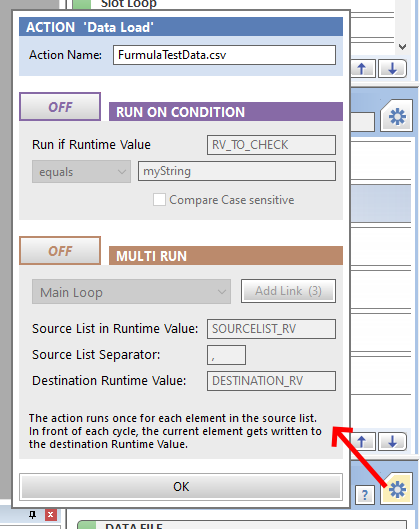
Condition¶

If switched on, the action will only run if the Runtime Value fulfills the comparison.
An activated condition is shown with the purple checkbox background in the sequence view:

Loop¶

If switched on, the action will run multiple times dependent on the list in
the source Runtime Value. Each element of the list will trigger one action
run. In front of each run, the current element gets written to the destination
Runtime Value. Beside this, a second Runtime Value with the same name +
_IDX will be created automatically which holds the loop number. Additional
lists can be linked to this process by pressing the “Add Link” button.
An activated Loop is shown with the orange “LOOP” marker in the sequence view:

Loop Example¶
Goal of the example is to loop a subsequence inside the workflow. Following Runtime Values are set from the beginning (this could e.g. be done by an external software on startup):
Name |
Value |
|---|---|
FILE_LIST |
C:\MyFileA.csv, C:\MyFileB.csv, C:\MyFileC.csv |
EXPORT_LIST |
YES, NO, YES |
The Loop of the “Run Sequence” action which calls the subsequence will get the following parameter:
Source RV (Main Loop) |
FILE_LIST |
Destination RV (Main Loop) |
DATAPATH |
Source RV (Linked Loop) |
EXPORT_LIST |
Destination RV (Linked Loop) |
DO_EXPORT |
The subsequence will now be called 3 times. During the first run, following Runtime Values will get set:
Name |
Value |
|---|---|
DATAPATH |
C:\MyFileA.csv |
DATAPATH_IDX |
1 |
DO_EXPORT |
YES |
And during the second run:
Name |
Value |
|---|---|
DATAPATH |
C:\MyFileB.csv |
DATAPATH_IDX |
2 |
DO_EXPORT |
NO |
Inside the subsequence, the Runtime Value DATAPATH may now be used as the input path for a “Data Load” action. DATAPATH_IDX may be used as Slot number or as Datafile Number in a “Data Exchange” action. DO_EXPORT may be used in a Condition of a “PDF Export” action.
Standard Parameter Input¶
Many action parameters can be defined with different input modes:

If its about a file path, you have the option to choose directly from the workspace folder. This “relative” path definition allows you to forward the workspace folder within its resource files to other places / PCs without the need to adapt any file paths.
The second option is an absolute path anywhere on your PC or network. Keep in mind that this path may be broken if you move your workspace folder to another PC.
The third option is to get the path from a Runtime Value, see Runtime Values.
List of Action Types¶
Action Load Document¶
Loads an Uniplot Document file (.ipz). Use in combination with the “Browse for File” action to provide User interaction.
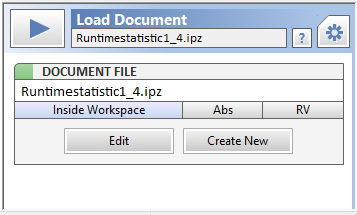
Parameter:
DOCUMENT FILE: Path to the .ipz file to be loaded.
Action Data Load¶
The action assigns a data file on disc to a Data Slot. Use in combination with
the “Browse for File” action to provide User interaction. Data Slots can then
be used by other actions or inside a script. Use in combination with the
/rv parameter in a batch file for automation.
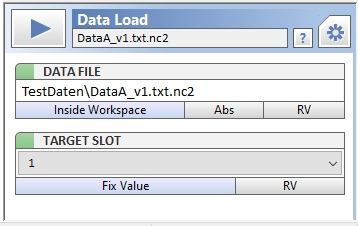
Parameter:
DATA FILE: The path to the datafile on disk.
TARGET SLOT: The Slot number where the data file will be assigned to.
Action Data Exchange¶
Executes a basic data exchange in the active document.
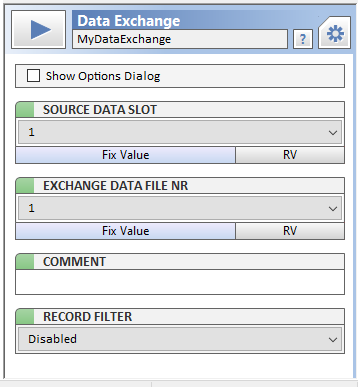
Parameter:
SHOW OPTIONS DIALOG: Opens the data exchange options dialog before executing.
SOURCE DATA SLOT: Slot number with the assigned data file.
EXCHANGE DATA FILE NR: Corresponds to the row number in the manual data exchange dialog.
COMMENT: Corresponds to the “Comment” column in the manual data exchange dialog.
RECORD FILTER: Enables the data point filter.
For further information related to the data exchange functionality in Uniplot, see Data=>Data Exchange (Document).
Action Snippet¶
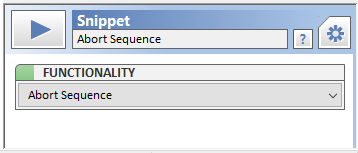
Snippets provide a set of basic and often used functionalities. For better understanding of the sequence flow, snippets get highlighted in the action list.
Parameter:
FUNCTIONALITY:
Following functionalities are available:
RESET ALL: Resets Slots, Global Object and Runtime Values. Typically used at the beginning of a sequence
ABORT SEQUENCE: Aborts the sequence flow
CLEAR RVs: Removes all active Runtime Values
LOG RVs: Writes all Rutime Values to the Uniplot Log. Useful for debugging
SHUTDOWN: Imediatly closes Uniplot, useful in automated workflows
Action Run Script¶
Loads and runs an Uniplot Script file (.ic).
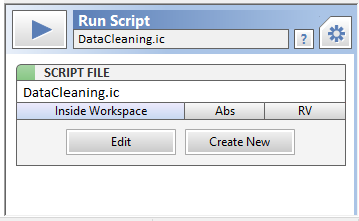
Parameter:
SCRIPT FILE: Path to the .ic file to be executed.
Script Functions:
Use following Uniscript functions in the script for interaction with the sequencer:
Seq_SetRuntimeValue("EXPORT_PDF", "TRUE")
(Creates and) sets the value of a Runtime Value.
Seq_GetRuntimeValue("EXPORT_PDF")
Receives the value of a Runtime Value.
Seq_SetSlotPath(3, "C:\MyFile.csv")
Assignes a data file to Slot (1-100).
Seq_GetSlotPath(3)
Receives the path of the data file assigned to slot (1-100).
Seq_GetWorkspacePath()
Receives the path to the current workspace folder.
Seq_AbortSequence(bShowAbortDialog)
Aborts the sequence execution after running the script. Shows a notification
dialog if bShowAbortDialog is 1.
Action Browse for File¶
Opens a File Dialog and writes the selected path into a Runtime Value. Provides user interaction for the workflow. You can for example predefine the path of a resource file with the “Set Runtime Values” action and, if temporary needed, overwrite it by switching on this action.
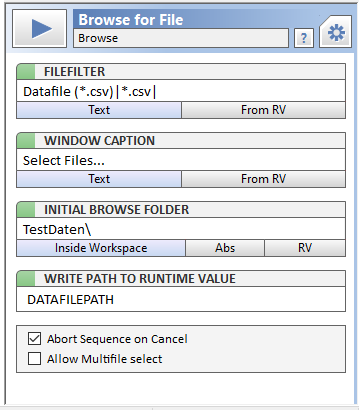
Parameter:
FILE FILTER: Filter for the file type in the upcoming dialog.
WINDOW CAPTION: Caption text for the upcoming dialog.
INITIAL BROWSE FOLDER: Start folder in the upcoming dialog.
WRITE PATH TO RUNTIME VALUE: Destination Runtime Value for the path of the selected file.
ABORT SEQUENCE ON CANCEL: The sequence flow will be aborted if the user presses cancel in the upcoming dialog.
ALLOW MULTIFILE SELECT: The User is able to select multiple files in the upcoming dialog. These file pathes will be stored comma separated in the destination Runtime Value. In further actions or sub sequence calls, you can activate the Loop functionality to iterate through the files automatically.
Action Browse for Folder¶
Opens a Windows Explorer window and writes the selected folder path into a Runtime Value. Provides user interaction for the workflow.

Parameter:
WINDOW CAPTION: Caption text for the upcoming dialog.
INITIAL BROWSE FOLDER: Start folder in the upcoming dialog.
WRITE PATH TO RUNTIME VALUE: Destination Runtime Value for the path of the selected folder.
ABORT SEQUENCE ON CANCEL: The sequence flow will be aborted if the user presses cancel in the upcoming dialog.
Action Run Sequence¶
Runs another sequence of the current workspace. Useful to structure complex workflows. Allows to switch On/Off or assign the Condition and Loop features to multiple actions at once. Also allows to reuse specific subsequences in several workflows.
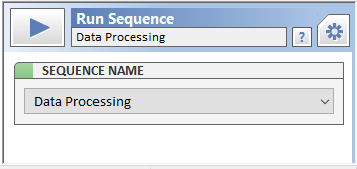
Parameter:
SEQUENCE NAME: Name of the sequence to run.
Run Sequence actions will be shown with an arrow button in the action list to navigate to the linked sequence:
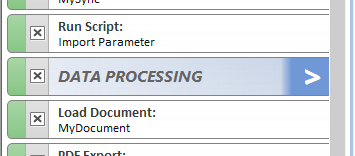
After navigation, the sequence view will show an arrow to navigate back:

Action Set Runtime Values¶
Sets a list of Runtime Values. Can e.g. be used for easy switching
between resource files and controlling of action Conditions/Loops. Can simulate
the batch start (parameter /rv) from external devices, very helpfull during
creation of the workflows.
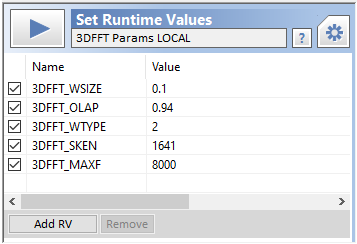
Parameter:
List of Runtime Values to be created.
The action also allows the creation of different parameter sets for scripts in combination with the UniScript function Seq_GetRuntimeValue. To do so, create a first set of parameters and copy/paste the action several times:
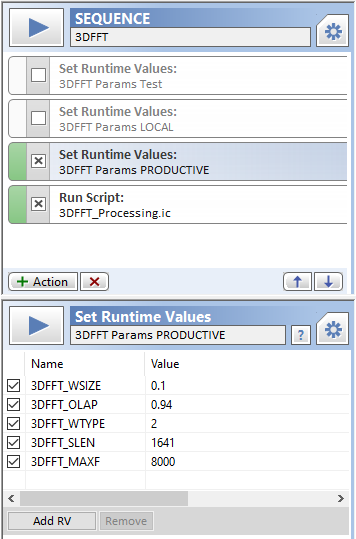
Now you can switch on the desired set of parameters manually or remote control the activation using action conditions. Read the values at the beginning of your script:

You can use the field functions @f{runtimevalue}, @f{date} and @f{time} for the value definition:

Action PDF Export¶
Exports a document as an PDF file.
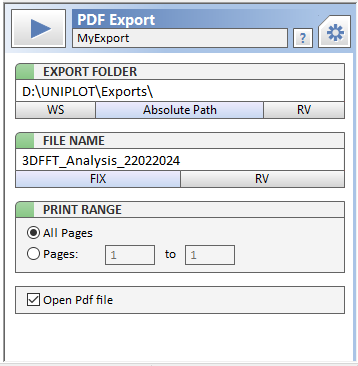
Parameter:
SOURCE DOCUMENT: Selects the document to be exported.
Active Document: The document of the active Uniplot window is used.
Handle from RV: Expects a number in the defined Runtime Value which refers to the handle of an existing document. There is no need for this document to be shown in the active Uniplot window. The Runtime Value may be automatically provided by the “Load Document” action or via UniScript. Note that handles are dynamic values which are created on document load.
EXPORT FOLDER: Destination folder for the exported pdf file.
FILE NAME: Name for the exported pdf file.
PRINT RANGE: Page selection.
OPEN PDF FILE: Opens the PDF file after creation if checked.
Note: You have to configure your PDF Config once after the installation of Uniplot, see File=>PDF-Export.
Action Picture Export¶
Exports the active document as a set of picture files.
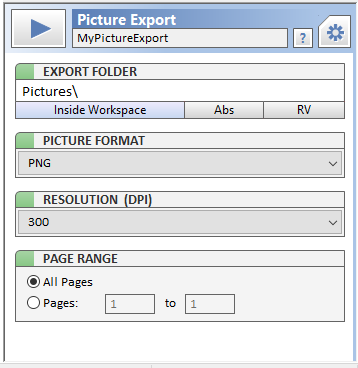
Parameter:
EXPORT FOLDER: Destination folder for the exported picture files.
PICTURE FORMAT: File format of the exported pictures.
RESOLUTION: Resolution of the exported pictures (DPI).
PRINT RANGE: Page selection.
Action Show Message¶
Opens a dialog box with up to two configurable buttons.

Parameter:
DIALOG CAPTION: Dialog caption.
DIALOG TEXT: Message text. The text will get center aligned if no icon is selected, else it will be left aligned. You can use the field functions @f{runtimevalue}, @f{date} and @f{time} in the text.
SHOW BUTTON: Shows / hides the button.
LABEL: Button label.
FUNCTION: Function after closing the dialog:
Do nothing: Simply closes the dialog.
Abort sequence: Stopps the sequence flow.
Set Runtime Value: Sets the Runtime Value “RV NAME” with the value “RV VALUE”
USER INPUT: Shows an input field.
LABEL: Label of the input field.
RV NAME: Runtime Value where the user input text gets written to. If the Runtime Value already has a value before, the input field gets prefilled with this value.
SAVE RV WITH BUTTON: The Runtime Value gets stored after pressing this button, else not.
Example dialog:

Buttons with the fuction “Set Runtime Value” may be useful to e.g. control action conditions.
Action Synchronize Files¶
Automates the UniScript function NC_SynchronizeTime
Automates the usage of the dialog File=>More File Functions=>Synchronize Data Files
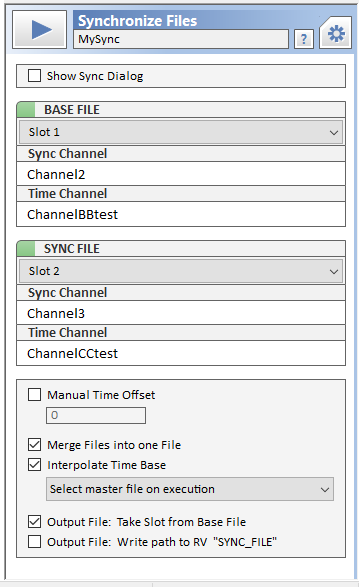
Parameter:
SHOW SYNC DIALOG: Opens and prefills the dialog File=>More File Functions=>Synchronize Data Files.
Action Export Data¶
Exports the data from a Data Slot. Automates the UniScript function NC_ExportData

Parameter:
FORMAT: Data format of the exported file
SOURCE DATA SLOT: Slot number with the assigned data file.
EXPORT FOLDER: Destination folder for the exported file.
FILE NAME: File name of the exported file.
OVERWRITE: Defines if the action is allowed to overwrite an existing file.
CHANNEL SELECTION: Allows to define which channels of the nc file will be exported. The action uses the same local channel list files as the manual menu function File=>Export Data.
On Play: The configuration dialog will be shown on action execution to select/create/edit the channel list.
Local File: The channel list with the defined name is used. Run the action with the option “Start Dialog” or use the additional function buttons to create a channel list.
Name from RV: The channel list with the name stored in the defined Runtime Value is used.
Edit / Select: Shortcut to edit or select the channel list for the option “Local File”. This function requires a reference data file loaded into the slot defined in “SOURCE DATA SLOT”.
Create New: Shortcut to create a new channel list for the option “Local File”. This function requires a reference data file loaded into the slot defined in “SOURCE DATA SLOT”.
Action Export Document¶
Exports an document.

Parameter:
SOURCE DOCUMENT: Selects the document to be exported.
Active Document: The document of the active Uniplot window is used.
Handle from RV: Expects a number in the defined Runtime Value which refers to the handle of an existing document. There is no need for this document to be shown in the active Uniplot window. The Runtime Value may be automatically provided by the “Load Document” action or via UniScript. Note that handles are dynamic values which are created on document load.
EXPORT FOLDER: Destination folder for the exported file.
FILE NAME: File name of the exported file.
Action Unit Conversion¶
Converts the units of the data in a slot. It uses the same mechanism and unit table like the menu function Tools=>Formula Configuration. Additionally, it allows the automatic usage of standard channel lists to define a subset of channels to convert.

Parameter:
DATA SLOT: Slot number with the data file to be converted.
UNIT TABLE FILE: Excel file with the unit definitions. “Default file” uses the configured file in Tools=>Formula Configuration.
DESTINATION UNIT: “SI Unit” converts to the unit of the column “SI Unit” in the unit table file. “Preferred Unit” converts to the unit of the column “Common Unit” in the unit table file which is marked with “1” in the column “Preferred”.
CHANNEL SELECTION: Allows to define which channels of the data file will be converted. The action uses the same local channel list files as the manual menu function File=>Export Data.
On Play: The configuration dialog will be shown on action execution to select/create/edit the channel list.
Local File: The channel list with the defined name is used. Run the action with the option “Start Dialog” or use the additional function buttons to create a channel list.
Name from RV: The channel list with the name stored in the defined Runtime Value is used.
Edit / Select: Shortcut to edit or select the channel list for the option “Local File”. This function requires a reference data file loaded into the slot defined in “DATA SLOT”.
Create New: Shortcut to create a new channel list for the option “Local File”. This function requires a reference data file loaded into the slot defined in “DATA SLOT”.
Snapshot of a unit table file:

Action Norm Names¶
The action uses the functionality of the AddIn “Norm Names” to translate header attributes and channel names of the data in a slot, see Norm-Names. Additionally, it may onvert the units of the data. Here, it uses the same mechanism and unit table like the menu function Tools=>Formula Configuration. If a forward and backward translation inside one workflow is needed, the action supports the modes “prepare reverse” + “reverse” where original names and units are remembered in the prepare run and restored in the reverse run.
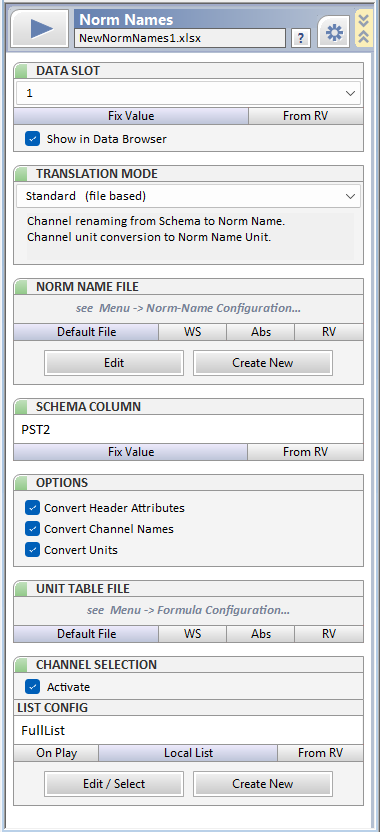
Parameter:
DATA SLOT: Slot number with the data file to be converted.
TRANSLATION MODE:
Standard: Forward translation only. Destination names and units are taken from configured files.
Standard + Prepare Reverse: Forward translation. Additionally, original names and units are written into the data.
Reverse: Backward translation. Destination names and units are taken from the previous run with the mode “Prepare Reverse”
NORM NAME FILE: Excel file with the norm names definition. “Default file” uses the configured file in Norm-Names.
SCHEMA COLUMN: Defines the Set of Norm Names in the Excel file.
OPTIONS: Activates the header names / channel names / unit translation separately.
UNIT TABLE FILE: Excel file with the unit definitions. “Default file” uses the configured file in Tools=>Formula Configuration.
CHANNEL SELECTION: Allows to define which channels of the data file will be converted. The action uses the same local channel list files as the manual menu function File=>Export Data.
On Play: The configuration dialog will be shown on action execution to select/create/edit the channel list.
Local File: The channel list with the defined name is used. Run the action with the option “Start Dialog” or use the additional function buttons to create a channel list.
Name from RV: The channel list with the name stored in the defined Runtime Value is used.
Edit / Select: Shortcut to edit or select the channel list for the option “Local File”. This function requires a reference data file loaded into the slot defined in “DATA SLOT”.
Create New: Shortcut to create a new channel list for the option “Local File”. This function requires a reference data file loaded into the slot defined in “DATA SLOT”.
See also
id-1715927